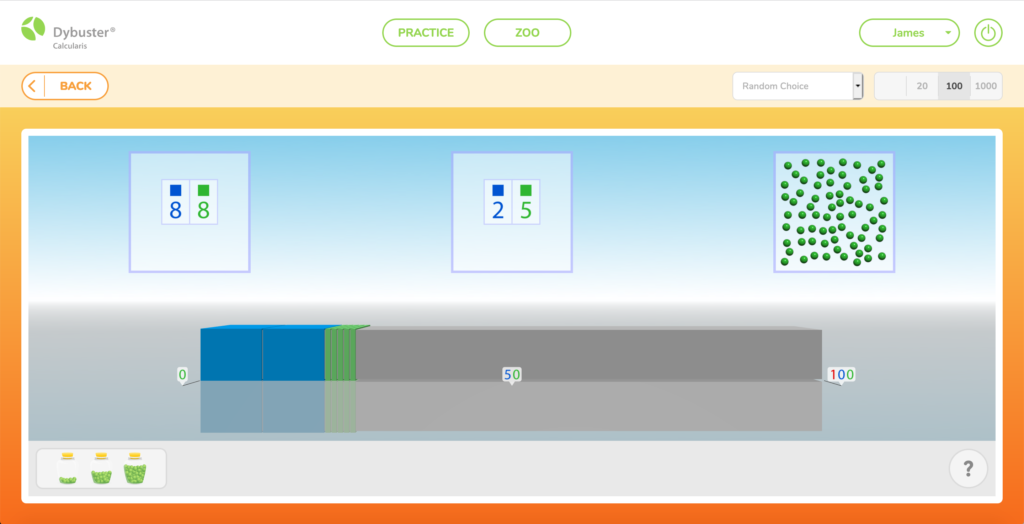Written by Natalie Kerslake B.A (Hons), MA Ed SEND
KS2 Teaching Assistant

A bit about me
My name is Natalie Kerslake B.A (Hons), MA Ed SEND, and I am a primary school teaching assistant, currently teaching in Year 6, with a particular interest in supporting children with special educational needs and disabilities. In January 2016, I graduated with my MA in Education with a specialism in Special Educational Needs and Disabilities (SEND) at the University of Derby.
In my first teaching assistant post, I became motivated to complete my MA Ed research on dyscalculia after supporting a child with this. I did not know anything about dyscalculia at the time, and not much was available to support teachers and children in this area. I wanted to investigate the current situation of supporting children with dyscalculia in one particular primary school and see whether this was the case in another school.
My MA Ed dissertation looked at how teachers and teaching assistants can effectively support children with dyscalculia in one primary school. My study found that more awareness and training need to be provided for teachers and teaching assistants to aid them in supporting children with dyscalculia. This includes knowledge of what dyscalculia is and what strategies can be used to support children effectively.
This leads me to my current role within the school. As part of my Continuing Professional Development this year, I wanted to raise awareness of dyscalculia within the school. Therefore, I invited all Teaching Assistants within my current school to complete a questionnaire asking a series of questions about dyscalculia, including ranking their current understanding of dyscalculia and identifying difficulties children with dyscalculia face in their learning along with strategies to help them in their education. From this, the TA’s wanted to learn more about dyscalculia, how to identify children with dyscalculia and finally, strategies to use to support children in the classroom. I thought I would write the rest of my blog outlining more information in these three main areas to help other practitioners understand dyscalculia.
Information about dyscalculia

What is dyscalculia?
I thought I would start by outlining what dyscalculia is. I often get asked by practitioners what dyscalculia is, as it is less well-known under the specific learning difference umbrella, unlike others, such as autism and dyslexia. Dyscalculia, according to the National Numeracy Strategy (cited in The Dyslexia Association, 2020), as the “ability to acquire arithmetic skills, problems in learning number facts and procedures, difficulty understanding number concepts and an intrusive grasp of numbers”. It is a specific learning difference relating to maths. It is a neurological condition involving the partial lobes of the brain, which reduces number sense and cannot be prevented.
There are many difficulties that learners can face, including telling the time, learning times tables, using fingers to count objects and recognising which number is bigger.
More information on the signs of dyscalculia can be found here.
Mathematical difficulties and dyscalculia
Another area is understanding the difference between mathematical difficulties and dyscalculia. This is because 25% of children are identified with mathematical difficulties, with around 5% being identified with dyscalculia (BDA., 2019).
My MA Ed research also highlighted this, where teachers could identify children with mathematical difficulties but not necessarily dyscalculia. This comes back to the lack of knowledge about dyscalculia and the ability to identify the difference between a child with general mathematical difficulties and those with dyscalculia.
Dyslexia and Dyscalculia
According to Butterworth and Yeo (2004, cited in Hannell, 2013), “between 20-60% of pupils have both dyslexia and dyscalculia” (Butterworth and Yeo, 2004, mentioned in Hannell, 2013, p. 5). Learners of both dyslexia and dyscalculia have difficulties with the processing and retrieval of information. This includes losing track of direction when reading and copying information.
However, although dyslexia and dyscalculia have similar features, much more is known about dyslexia than dyscalculia. This is illustrated in the findings found by Murphy et al. (2007 cited in Reid, 2009), who found that in 21 years, 1,077 articles were looking at dyslexia, compared to 231 articles in the same time frame looking at maths difficulties.
Memory and Processing
The role of memory and how learners process information is an important one. This is in terms of how learners can process and understand what is being taught and retrieve this information when needed.
This is where the role of the different parts of memory is involved, whether remembering information for a short time, such as writing down a phone number, which is kept in the working memory or short-term memory until no longer required. Alternatively, information that needs to be remembered over a more extended period, such as remembering times tables’ facts and procedures, is transferred into the long-term memory.
Children with dyscalculia have difficulties in being able to remember information such as times table facts, as well as retaining the different steps in solving word problems, impacting both their working/short-term and longer-term memory. Strategies will then need to be put in place to improve these learners’ memory functions, to enhance their mathematical skills.
Identifying children with dyscalculia

Many checklists can help ‘identify’ children with dyscalculia. However, these checklists will only indicate dyscalculia and not an actual diagnosis. This will need to be completed by an Educational Psychologist. However, some of the main checklists that can be used to help identify children with dyscalculia include:
Dyscalculia Screener – Brian Butterworth
The Dyscalculia Screener covers four main areas
Reaction time (clicking a button when dots appear on the screen)
Dot enumeration (counting the number of dots on a screen
Number comparison (comparing two numbers and finding out which one is more)
Arithmetic achievement (addition and multiplication questions)
These tests determine whether a pupil has dyscalculia or ‘low numeracy’ (Emerson and Babtile, 2013, p 153)
The Dyscalculia Assessment – Jane Emerson and Patricia Babtile
The Dyscalculia Assessment covers six main areas, which are:
- Number Sense and Counting
- Calculation
- Place Value
- Multiplication and Division
- Word Problems
- Formal Written Numeracy
Questions are provided in each area, and a summary is completed at the end of the assessment. Only indicates difficulties, not an actual diagnosis of dyscalculia.
A checklist for Dyscalculia and Maths Learning Difficulties – Steve Chinn
This checklist looks at 39 different statements children with dyscalculia and mathematical difficulties may struggle with. Each statement is based on a ranking scale of between one and three – with one not happing very often and three always happening.
Once all of the statements in the checklist have been completed, each statement’s ranking is added to give a total.
Again, it will not diagnose dyscalculia, but the higher the score, the more difficulties the child faces with maths. It will, however, highlight what difficulties that child may meet with mathematics and interventions and strategies can then be put in place to support this child effectively with their learning.

Many strategies can be used to support children with dyscalculia in the classroom, including using real-life concepts in word problems, using flashcards and displaying key information on working walls, using songs, and allowing for extra time to complete any task.
I thought I would go into five strategies in more detail that can be used to support these children, along with different intervention programmes that can be used to support these children in the classroom.
Use of concrete and pictorial resources
Concrete and pictorial resources allow the child to see the mathematical problem visually, which helps children with dyscalculia and mathematical difficulties to understand the question being asked. It also enables children to use concrete materials as the first part of the Concrete, Pictorial and Abstract approach, commonly referred to as the CPA approach.
Many examples of concrete resources can be used in the classroom. I have just listed a few that I have used in class:
- Buttons
- Bottle tops
- Base 10
- Numicon
- Counters
- Cubes
- Tens Frame
The list goes on…… What is important here is that all children, not just those with mathematical difficulties – including dyscalculia can see the problem in the concrete form before seeing the question in the pictorial and the abstract concept.
Dot/Dice pattern
Children with dyscalculia must first learn the dot/dice patterns for numbers 1-6 before extending this to 10. This is because it helps children to add two numbers together quickly using this pattern, easing any capacity on the working and long-term memory. An example of this is adding 5 + 2. As the child has already learnt the pattern for representing numbers up to 6, this makes this process easier afterwards by adding the two numbers together.
One way of doing this is using two 6-sided dice and using this method to add up the dots of different numbers, up to 12. This would be a fun way of introducing the dot/dice pattern to children. If a child, for example, were asked to add 5 and 4, instead of counting them one by one, they would be able to start on 5 and then add 4 more.
A helpful website to learn more about this is the website Spot on with Numbers, which gives more information about the Dot and Dice pattern.
Times Tables
Chinn (2007, cited in Holliman 2014) states that learners do not need to know all their times tables but only their 1s, 2s, 5s and 10s. From only knowing these four tables, learners can work out others without learning them, for example, the seven times tables, using the knowledge of 5s and 2s.
This allows learners to recall their times tables more quickly, easing any capacity on the working and long-term memory. It will also alleviate any anxiety and difficulties that learners’ may face in the recall and retention of learning times tables.
Use of games and technology

One strategy that could be used to overcome difficulties faced with number processing, memory and arithmetic are games. Many different games can be used to support learners, such as those on paper or completed on the computer.
Some of the ones that I have used within the classroom include:
- Hit the Button – a look at times tables and other related mathematics activities.
- Times Table Rockstars
- Mathletics
- Purple Mash
There are many others available, as well as games such as number bingo that can also be used to support children with dyscalculia in the classroom.
Using different colours to help children understand mathematical concepts
Underlining addition, subtraction, multiplication and division questions in a different colour will help children with dyscalculia. This is because using colours allows children to distinguish between the other questions and helps them identify what is being asked in each question.
I have also found that using different colours helps in other aspects of mathematical learning, including those with dyscalculia. This includes using two different colours to represent number bonds to 10 and 20 – using cubes and through the use of tens frames.
Intervention programmes
Several intervention programmes can be used to support children with dyscalculia. This includes Dynamo Maths, Five Minute Number Box and Plus 1 and the Power of 2.
Dynamo Maths offers an assessment and intervention program to support children with mathematical difficulties, including dyscalculia. The assessment provides teachers with specific information on the areas where children with dyscalculia have difficulty.
Five Minute Number Box also offers a multi-sensory intervention program that supports children with dyscalculia.
Plus One, Power of 2, Perform with Time and Times table books, which offer daily repetitive practice around mathematical concepts to support these children.
Other useful resources

Books
- Bird, R (2017) The Dyscalculia Toolkit: Supporting Learning Difficulties in Maths, 3rd Edition, London: Sage Publications
- Butterworth, B (2003) The Dyscalculia Screener, London: NFER- Nelson
- Chinn, S. (2019) Maths Learning Difficulties, Dyslexia and Dyscalculia, 2nd Edition, London: Jessica Kingsley Publishers
- Emerson, J, Babtile, P (2010) The Dyscalculia Assessment, London: Continuum
- Hornigold, J. (2015) Dyscalculia Pocketbook, Alresford: Teachers’ Pocketbook
- Hornigold, J. (2020) Can I Tell You About…Dyscalculia, London: Jessica Kingsley Publishers
Websites
- Number Stacks – resources to help teach different number concepts.
- Maths Explained – Steve Chinn – series of videos and activities.
- Maths Bot – lots of manipulatives to use.
Thank you for taking the time to read my blog – I hope it has given you some insight into what dyscalculia is, how it can be identified, and different strategies to support these children within the classroom environment.
References
2 Simple Ltd (2020) Purple Mash, https://www.purplemash.com, accessed on 29/04/20
3P Learning (2020) Mathletics, https://www.mathletics.com/uk/, accessed on 29/04/20
Bird, R (2017) The Dyscalculia Toolkit: Supporting Learning Difficulties in Maths, 3rd Edition, London: Sage Publications
British Dyslexia Association (2019) Neurodiversity and Co-occurring differences, https://www.bdadyslexia.org.uk/dyslexia/neurodiversity-and-co-occurring-differences/dyscalculia-and-maths-difficulties, accessed on 04/01/20
Butterworth, B (2003) The Dyscalculia Screener, London: NFER- Nelson
Chinn, S (2014) Maths Explained, https://www.mathsexplained.co.uk, accessed on 04/01/20
Chinn, S. (2019) Maths Learning Difficulties, Dyslexia and Dyscalculia, 2nd Edition, London: Jessica Kingsley Publishers
Chinn, S (2019) The dyscalculia checklist, http://www.stevechinn.co.uk/dyscalculia/the-dyscalculia-checklist, Accessed on 30/10/19
Dynamo Maths (2014) http://www.dynamomaths.co.uk, accessed on 05/06/15
Dyscalculia Blog (2016) More Awareness & Training needs to be Provided for Teachers…to aid them in Supporting Children with Dyscalculia, https://dyscalculia-blog.com/2016/08/25/awareness-teachers-children-dyscalculia, accessed on 04/01/20
Emerson, J, Babtile, P (2010) The Dyscalculia Assessment, London: Continuum
Five Minute Number Box ( 2020) https://www.fiveminutebox.co.uk/the-five-minute-number-box, accessed on 04/01/20
Hannell, G (2012) Dyscalculia: action plans for successful learning in mathematics, 2nd Edition, London: Routledge
Holliman, A. (2014) The Routledge international companion to educational psychology, Abingdon: Routledge
Maths Bot (no date), www.mathsbot.com, accessed on 08/01/20
Maths Circle Ltd (no date) Times Table Rockstars, https://ttrockstars.com/, accessed on 29/04/20
Number Stacks (2019) https://www.numberstacks.co.uk, accessed on 04/01/20
Power of 2 (2016) Times tables, https://www.123learning.co.uk/maths-support-book-times-tables
Power of 2 (2016) Maths support book – Plus 1, https://www.123learning.co.uk/maths-support-book-plus-1
Power of 2 (2016) Maths support book – Power of 2, https://www.123learning.co.uk/maths-support-book-power-of-2/
Power of 2 (2016) Perform With Time, https://www.123learning.co.uk/maths-support-book-perform-with-time/
Reid, G. Peer, L (2011) Special educational needs: a guide for inclusive practice, London: SAGE Publications.
Spot on with Numbers (2019) https://www.spotonwithnumbers.co.uk/, accessed on 08/01/20
The Dyslexia Association (2020) What is Dyscalculia, https://www.dyslexia.uk.net/specific-learning-difficulties/dyscalculia. Accessed on 04/01/20
Topmarks Online Ltd (2020) Hit the Button, https://www.topmarks.co.uk/maths-games/hit-the-button, accessed on 29/04/20
Hi Ms.Natalie,
Your work is really inspiring. I’ve been doing a research similar to this topic. May I Know if I can use your questionnaire for my study? Thank you very much.
Would be extremely interested to read your dissertation but it’s not referenced so iassume its unpublished? 🙁
Is there any way I can get my hands on this or speak with you about your findings?
Hi DeBurca,
I think the best way to contact Natalie about her dissertation would be to message her on twitter https://twitter.com/MissK_KS2 🙂